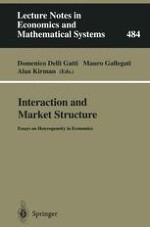2000 | Buch
Interaction and Market Structure
Essays on Heterogeneity in Economics
herausgegeben von: Prof. Domenico Delli Gatti, Prof. Mauro Gallegati, Prof. Alan Kirman
Verlag: Springer Berlin Heidelberg
Buchreihe : Lecture Notes in Economics and Mathematical Systems
Enthalten in: Professional Book Archive
